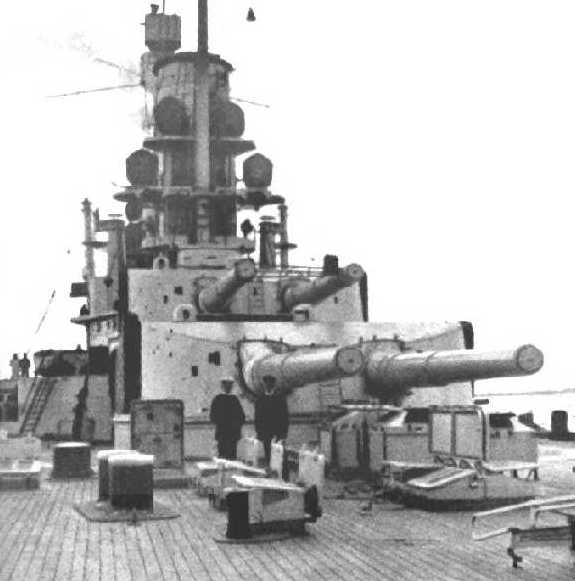| Type |
Cartridge - Bag |
| Projectile Types and Weights |
World War I
APC L/3,4 - 894 lbs. (405.5
kg)
HE L/3,8 - 894.8 lbs. (405.9
kg)
World War II
APC L/3,4 - 892.9 lbs. (405
kg)
APC L/4,9 - 915 lbs. (415
kg)
HE L3,8 base fuze - 915 lbs.
(415 kg)
HE L/5 base fuze - 915 lbs.
(415 kg)
HE L/4,8 nose fuze - 892.9
lbs. (405 kg)
Special Coastal Artillery Projectile
HE L/3,6 base and nose fuze
- 551 lbs. (250 kg) |
| Bursting Charge |
World War I
APC L/3,4 - 30.0 lbs. (13.6
kg)
HE L/3,8 - 59.5 lbs. (27.0
kg)
World War II
APC L/3,4 - 25.4 lbs. (11.5
kg)
APC L/4,9 - N/A
HE L/3,8 base fuze - 59.5
lbs. (27.0 kg)
HE L/5 base fuze - N/A
HE L/4,8 nose fuze - 58.4
lbs. (26.5 kg)
HE L/3,6 base and nose fuze
- 32.0 lbs. (14.5 kg) |
| Projectile Length |
World War I
APC L/3,4 - 40.8 in (103.7
cm)
HE L/3,8 - 48.38 in (122.9
cm)
World War II
APC L/3,4 - 40.8 in (103.7
cm)
APC L/4,9 - 58.8 in (149.5
cm)
HE L/3,8 base fuze - 45.6
in (115.9 cm)
HE L/5 base fuze - 60.0 in
(152.5 cm)
HE L/4,8 nose fuze - 52.6
in (133.5 cm)
HE L/3,6 base and nose fuze
- 55.1 in (140 cm) |
| Propellant Charge |
World War I
Main Charge: 201 lbs.
(91 kg) RP C/12
Fore Charge: 76 lbs.
(34.5 kg) RP C/12
World War II (as of 1940)
For APC L/3,4 and HE L/4,8
nose fuze
Main Charge
- 188.3 lbs. (85.4 kg) RP C/32
Fore Charge
- 91.7 lbs. (41.6 kg) RP C/32
For HE L/3,6 base and nose
fuze
Main Charge
- 188.3 lbs. (85.4 kg) RP C/32
Fore Charge
- 135.8 lbs. (61.6 kg) RP C/32
Total main cartridge weight:
313 lbs. (142 kg)
Silk bag for fore charge:
5.3 lbs. (2.4 kg)
After 1942 (see Note 3)
APC L/4,9 - 268 lbs. (121.5
kg) RP C/38 (18/8)
HE L/3,6 - 315 lbs.
(143 kg) RP C/38 (18/8) |
| Muzzle Velocity |
World War I
2,805 fps (855 mps)
World War II
APC L/3,4 - 2,805 fps (855
mps)
APC L/4,9 - 2,789 fps (850
mps)
HE L3,8 base fuze - 2,789
fps (850 mps)
HE L/5 base fuze - 2,789
fps (850 mps)
HE L/4,8 nose fuze - 2,805
fps (855 mps)
HE L/3,6 base and nose fuze
- 3,675 fps (1,120 mps) |
| Working Pressure |
20.9 tons/in2 (3,300 kg/cm2) |
| Approximate Barrel Life |
200 rounds |
Ammunition stowage per gun
(see Note 4) |
Helgoland: 85 rounds
Kaiser: 86 rounds
König and Derfflinger: 90 rounds |
| Notes:
1) These guns, like most large caliber
German guns of this era, used a "fore charge" which was propellant in a
double bag silk case and a "main charge" which was propellant in a brass
case. The brass case helped to seal the breech of the gun.
2) APC shells were painted blue, HE yellow
and Training red. A black painted nose indicated that the shell was
armed.
3) I lack the break down between fore and
main charges for the 1942 propellant charges.
4) Outfits were typically 70% APC and 30%
HE. Outfit for Derfflinger class was 65 APC and 25 HE per gun.
British post-war documents claim that the König class carried 96 to
100 rounds per gun and that the Kaiser class carried 98 to 103 rounds per
gun.
5) Actual Projectile designations were
as follows:
World War I
APC L/3,1 - Psgr. L/3,1 (mhb)
HE L/3,8 - Spr.gr. L/3,8
Bdz
World War II
APC L/3,4 - Psgr. L/3,4 (mhb)
APC L/4,9 - Psgr. L/4,9 (mhb)
HE L/3,8 base fuze - Spr.gr.
L/3,8 Bdz
HE L/5 base fuze - Spr.gr.
L/5 Bdz
HE L4,8 nose fuze - Spr.gr.
L/4,8 Kz
HE L/3,6 base and nose fuze
- Spr.gr. L/3,6 Bdz u. Kz (mhb)
Diagrams of some of these projectiles and
their fuzes and charges may be found at the additional pictures link above. |
